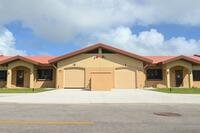The quality of military housing is a key component of military readiness, but living on a military base might not be the right situation for every military family.
Pros, or positives, to living on base include tightly knit military communities and the military’s standards for adequate housing. Cons, or negatives, include the fact that some service members have no choice but to live on base; and that the Defense Department and the companies that operate on-base privatized housing don’t always meet the standards for adequacy.
Here's a short list of pros and cons to living on a military base for you and your family to consider:
What Are the Pros to Living on Base?
Quality Military Housing
The DoD's incentive to provide quality housing is to help retain the best personnel for its all-volunteer military force. The proportion of personnel extending their service from bases with high-quality housing is higher than for those stationed at places with low-quality housing. The DoD considers housing to be of adequate quality if it meets minimum standards for configuration, privacy, condition, health and safety -- although inadequate housing isn't necessarily considered uninhabitable.
A Welcoming Military Community
When you move to your new military installation, you'll have a tightly knit military community ready to welcome you and your family. You may not have as much privacy as you'd wish, with your spouse's commanding officer and unit members living next door or right around the corner. However, you'll have spouses nearby who are ready to help you get settled into your new environment, and you'll likely be closer to the tax-free shopping on base.
Availability of Appropriate Housing
In areas where private-sector housing falls short in terms of cost, commuting distance, and other criteria, the DoD operates barracks for unaccompanied personnel, military family housing for members with dependents, and temporary lodging for military families who are changing stations or service members on temporary duty.
What Are the Cons to Living on Base?
Unaccompanied Quarters
Junior enlisted service members without dependents must live unaccompanied quarters, or barracks, where they share a room with at least one other person and a communal bathroom. About half a million service members live in these quarters, which are often substandard, inadequately maintained, or obsolete.
Inadequate Housing
Some government-owned military housing, in particular, can be dilapidated, too small, lacking in modern amenities or substandard. In fact, the Government Accountability Office reported in 2023 that it had visited installations with “a variety of living conditions that service members and unit leaders stated were negatively affecting their quality of life, such as sewage overflow, mold and mildew, and broken windows and locks.”
Within privatized family housing, the GAO said the DoD had not “set clear and consistent inspection standards for homes undergoing change of occupancy” nor “provided adequate guidance or training to officials on assisting residents in using a new formal dispute resolution process.”
If you're still unsure of where you want your military family to live when you get your PCS orders, you could consult your on-base financial counselor at your old and new duty stations. Don't be afraid to ask other military families living on base or around it what they think of living on an installation, and ask to join installation-specific social media groups to field questions.
Keep Up-to-Date for Your Next PCS
Get the inside information from those who know. Get PCS help and all the news and benefits information you need delivered straight to your inbox. Sign up for a free membership today.














